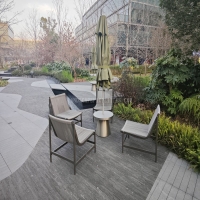Welcome to the website for landscape facilities products and knowledge.
How does the table’s design account for the need for personal space in shared work environments?
In contemporary shared work environments, table design plays a crucial role in addressing the fundamental human need for personal space while facilitating collaboration. Modern office tables incorporate several strategic elements that create psychological and physical boundaries without isolating workers.
Partition integration represents one of the most effective approaches. Tables now frequently feature subtle, transparent dividers that provide visual separation while maintaining an open atmosphere. These partitions, often crafted from materials like tempered glass or acrylic, create a sense of individual territory without the claustrophobic feel of traditional cubicles.
Zoning through table configuration offers another sophisticated solution. Designers create tables with varied heights, curved edges, and strategically placed planters or storage units that naturally delineate personal workspace. This approach establishes clear territorial boundaries while maintaining visual connectivity across the shared environment.
The incorporation of personal technology zones further enhances individual space. Many modern tables include built-in power outlets, USB ports, and cable management systems positioned specifically within each user's designated area. This not only provides functional convenience but also reinforces the psychological concept of personal territory through technological ownership.
Ergonomic considerations extend beyond physical comfort to spatial awareness. Tables designed with appropriate depth and width measurements ensure users don't feel encroached upon by neighboring colleagues. The standard recommendation of approximately 60-70 centimeters of personal width per user has been shown to significantly reduce spatial discomfort in shared settings.
Acoustic management through material selection represents another critical design element. Tables incorporating sound-absorbing materials in key areas help create auditory privacy, which is equally important as visual privacy in shared spaces. This approach minimizes distractions while allowing for necessary collaboration when needed.
Adaptable furniture systems provide the ultimate flexibility. Many organizations now implement tables with modular components that can be rearranged based on specific tasks and privacy requirements. This empowers employees to customize their immediate environment according to their changing needs throughout the workday.
The psychological impact of these design choices cannot be overstated. Research indicates that workers in properly designed shared spaces report higher job satisfaction and reduced stress levels. The subtle cues provided by thoughtful table design help establish territorial boundaries that respect individual needs while maintaining the collaborative benefits of open environments.
Color and material psychology further enhances the personal space experience. Designers increasingly use warmer materials and softer textures at individual work points, creating subconscious markers of personal territory within the larger shared surface.
Ultimately, successful table design in shared work environments represents a sophisticated balance between openness and enclosure, collaboration and concentration. By addressing both the physical and psychological aspects of personal space, modern office tables create environments where productivity and well-being can coexist harmoniously.
Related search:

Recommendation
Metal structure rattan chair without armrests for single person, with woven seat and backrest.